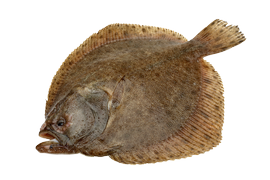
TURBOT AND BRILL
The compact body of a turbot has no scales and is almost completely round. The color varies according to the conditions on the sea bed but tends to be dark. Brill is very similar to its larger relative but has a thinner body and lacks the rough quills on the top side.
Fish facts
Unlike their flat relatives in the same family which live at the bottom of the sea, both these fish are left-eyed.
Turbot are now farmed.
How to cook turbot
The taste and consistency of the delicate flesh of these fish is hard to beat. Turbot has slightly firmer flesh and is therefore easier to cook.
Fishmongers and gourmets prefer to let turbot rest on ice for a few days. They think it makes it easier to skin and improves the flavor too.
Some think that the band of flesh just inside the fins is the best tasting part of the fish.
Estimate 0.5 kg per person if baking the fish whole in the oven. The main rule then is: The bigger the fish, the lower the temperature (and the longer the cooking time). Use a thermometer and don’t let the internal temperature exceed 52°C.
The classic
Whole turbot oven-baked at 100°C – or just below – until the flesh comes away from the backbone. Serve this attractive fish whole as a centerpiece, with melted butter and freshly grated horseradish.
Conservation status:
Farmed turbot and line-caught turbot larger than 30 cm from sustainable stock have yellow status. Other wild-caught turbot has red status. Brill is in the risk zone too.








